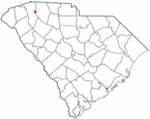Apalache Mill
Apartment buildings in South CarolinaBuildings and structures in Spartanburg, South CarolinaIndustrial buildings and structures on the National Register of Historic Places in South CarolinaNational Register of Historic Places in Spartanburg, South CarolinaTextile mills in South Carolina ... and 1 more
Upstate South Carolina Registered Historic Place stubs

The Apalache Mill, now the Lofts by the Lake, is a historic textile mill at 2200 Racing Road in Apalache, South Carolina. The main mill building, a three-story brick building with plain late-19th century styling, sits at the southern end of Apalachee Lake, created by damming the Tyger River at a narrow gorge just to the east. Built in 1888, it is one of the first mills to be built in the Spartanburg area, and remained in active service until 2007.The mill was listed on the National Register of Historic Places in 2015. The listing includes the mill and associated water power infrastructure, including a water tower and the lake.
Excerpt from the Wikipedia article Apalache Mill (License: CC BY-SA 3.0, Authors, Images).Apalache Mill
Racing Road, Greer
Geographical coordinates (GPS) Address External links Nearby Places Show on map
Geographical coordinates (GPS)
| Latitude | Longitude |
|---|---|
| N 34.962222222222 ° | E -82.208333333333 ° |
Address
Apalache Mill
Racing Road 2200
29651 Greer
South Carolina, United States
Open on Google Maps








